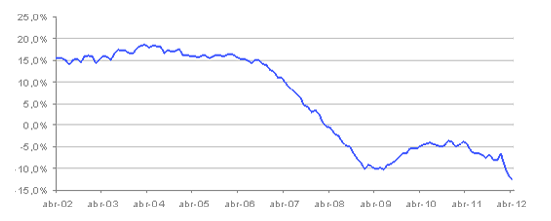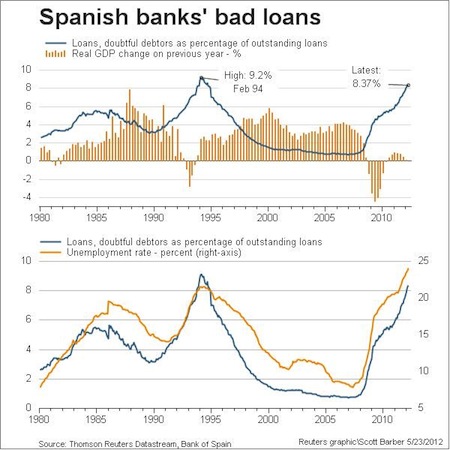It seems it always takes the taxpayer to be on the hook before the true depth of the a nation’s banking systems issues can truly come to light:
Spain’s banking crisis worsened Friday as the board of Bankia, the country’s biggest mortgage lender, warned that it would need an additional 19 billion euros ($23.88 billion), far beyond what the government estimated when it seized the bank and its portfolio of delinquent real estate loans earlier this month.
The government is trying to head off a collapse of the bank, which could threaten the Spanish banking industry and reverberate through the financial centers of Europe and beyond. The fear is that it will not have the money to save its banks, and their $1.25 trillion in deposits, and will need a rescue by the rest of Europe — even as political and financial leaders struggle to resolve Greece’s debt debacle.
Bankia’s announcement came as Standard & Poor’s, the credit ratings agency, downgraded Bankia and two other banks, Banco Popular and Bankinter, to junk status and lowered the ratings of two other Spanish banks also staggered by mounting bad loans. A junk rating could make it even harder for Bankia to borrow its way out of trouble.
It should be remembered that it was only two weeks ago that the Spanish finance minister, Luis de Guindos, said that €15bn was all that would be needed to shore up the entire banking system. Given the state of Spanish government finances you would wonder exactly where the Spanish government is expected to find this additional €19 billion. How about a reverse LTRO?
Spain’s government plans to force Europe’s central bank into sharing the task of bailing out its troubled financial sector in a potentially controversial move that could spark objections from the German chancellor, Angela Merkel.
Spain is considering proposals to inject €19bn (£15bn) of capital into nationalised Bankia in the form of government debt that could then be used to raise money from the European Central Bank (ECB), forcing it to get involved in what may become a far wider bailout of Spain’s creaking banking sector.
Details remain sketchy, but sources in Madrid confirmed that a refinancing involving the ECB was the most probable way forward for a Spanish government that will have trouble raising €19bn itself at a manageable interest rate.
By avoiding the markets altogether, the government would indirectly “push the financing of Bankia’s bailout on to the ECB”, according to El País newspaper.
And so the interconnectivity between the weakening sovereign and the weakening banking system gets tighter. Spanish banks have over €140bn of Spanish government debt on their books, up from around €50bn prior to the ECB’s 3 year LTRO, but there is little end in sight for Spain’s problems. The latest housing market data shows very clearly that the issues in that sector are far from over
 YoY housing market Index change – Source: Tinsa.net
YoY housing market Index change – Source: Tinsa.net
And bad and doubtful debts in the banking system continue to mount as unemployment moves higher towards 25%.

Mario Rajoy, the Spanish PM, spent much of the last 2 weeks attempting to convince the ECB to provide some more immediate support for his country in order to bring down Spanish yields. His efforts, however, weren’t helped by Spain’s regional governments.
Catalan premier Artur Mas on Friday urged the government to set up a mechanism that allows Spain’s regions to tap the financial markets to meet the payment of maturing debts.
“I don’t care what sort of mechanism it is, but we have to make payments every month,” Mas said in a meeting with reporters working for the foreign media. “The economy can’t recover if you don’t pay your bills.
The regions have been pushing the government to approve the creation of so-called hispanobonds, which would be issued by them but guaranteed by the central government. This would allow them to access the debt market at rates close to those of the sovereign. Valencia was recently forced to offer yields of over seven percent to raise 500 million euros in shorter-term bills, more than that paid by bailout recipients Greece and Portugal.
Catalonia, which accounts for about a fifth of Spain’s GDP, is facing debt maturities of some 13.4 billion euros this year.
There is 5 weeks until the next EU summit at which time European Commission President Jose Manuel Barroso, European Central Bank President Mario Draghi, Eurogroup Chairman Jean-Claude Juncker and European Council President Herman Van Rompuy are supposed to deliver a new template for the further of the Eurozone focussing on tighter integration and growth.
However, given the increasing Spanish bond yields it seems likely that we will see some more immediate action before that time. Although Spanish authorities continue to deny the need, I suspect an external bailout via the ESM, IMF, or both, is on the way.